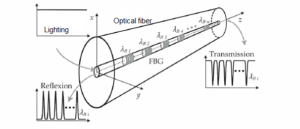 Researchers have presented dynamic gratings used instead of depending on fixed-position fiber Bragg gratings, and now core-launched laser beam light can unite to the cladding modes of conventional optical fiber resulting in distributed fiber sensing of the external environment.
Researchers have presented dynamic gratings used instead of depending on fixed-position fiber Bragg gratings, and now core-launched laser beam light can unite to the cladding modes of conventional optical fiber resulting in distributed fiber sensing of the external environment.
The thing is that fiber optic sensors allow distinguishing between chemicals and liquids external to the optical fiber, herewith, they are usually based on refractive-index changes in the cladding modes of the fiber. Moreover, fixed-position fiber Bragg gratings (FBGs) are applied to excite these cladding modes and unite laser beam light from the core mode.
Nevertheless, FBG sensors need specific equipment to create the gratings at the optical fiber, also they only work as point sensors at specific, predetermined locations. A team of researchers from Israel tries to overcome these challenges by developing dynamic gratings at reconfigurable short sections along with the optical fiber.
Thus, the new gratings are independent of any permanent change in the fiber structure. It is possible to switch them on and off at will, and fiber optic sensors based on dynamic gratings allow scanning along with the optical fiber. According to researchers, after the installation of a grating, its effect is not restricted only to light in the core mode.
Similar to conventional FBGs, the dynamic gratings also unite laser beam light between core and cladding modes. Herewith, in analogy to fiber Bragg gratings, such connection will occur for the light at very specific frequencies. “An optical probe wave of tunable frequency is launched at the dynamic grating, and the exact frequency in which coupling takes place is carefully noted.”
Compared to FBGs, dynamic gratings enable the researchers to carry out tests in any chosen position. It should be noted that the developed fiber optic sensors have been already tested over 2 m of traditional optical fiber. To be more precise, fiber sensors consisted of 8 cm length dynamic gratings perform scanning along with the optical fiber resulting in the combination of spectra between core and cladding modes in each position.
Measurements accurately detect the parts of optical fiber that were immersed in ethanol and water, herewith, the fiber sensors can distinguish between the two with an 8 cm resolution. At the same time, the refractive index outside the fiber is possible to estimate precisely with fourth-decimal-point accuracy (0.0004).
Optromix is a fast-growing vendor of fiber Bragg grating (FBG) product line such as fiber Bragg grating sensors, FBG interrogators and multiplexers, Distributed Acoustic Sensing (DAS) systems, Distributed Temperature Sensing (DTS) systems. The company creates and supplies a broad variety of fiber optic solutions for monitoring worldwide. If you are interested in structural health monitoring systems and want to learn more, please contact us at info@optromix.com


 Researchers have been firstly created a
Researchers have been firstly created a  It is highly essential to have accurate spatial information of a medical device inside the patient for proper manipulation of the instrument. The thing is that a wide range of clinical applications requires spatial information. Nevertheless, each technique has its disadvantages, the promising solution is the application of
It is highly essential to have accurate spatial information of a medical device inside the patient for proper manipulation of the instrument. The thing is that a wide range of clinical applications requires spatial information. Nevertheless, each technique has its disadvantages, the promising solution is the application of  Tunnel fires are not regarded as usual, however, they also can perform great damage to lives and properties if they take place. The process of fire detection inside the lengthy and curved tunnel is challenging. Nevertheless,
Tunnel fires are not regarded as usual, however, they also can perform great damage to lives and properties if they take place. The process of fire detection inside the lengthy and curved tunnel is challenging. Nevertheless, An electrical engineer from the Netherlands has developed a
An electrical engineer from the Netherlands has developed a  A team of researchers from the U.S. continues developing a
A team of researchers from the U.S. continues developing a  A new compact
A new compact  A team of researchers offers a new application of
A team of researchers offers a new application of The opportunity to measure body temperature plays a crucial role in both physiological studies and clinical investigations. New wearable sensors based on
The opportunity to measure body temperature plays a crucial role in both physiological studies and clinical investigations. New wearable sensors based on  A company from Australia offers a novel
A company from Australia offers a novel